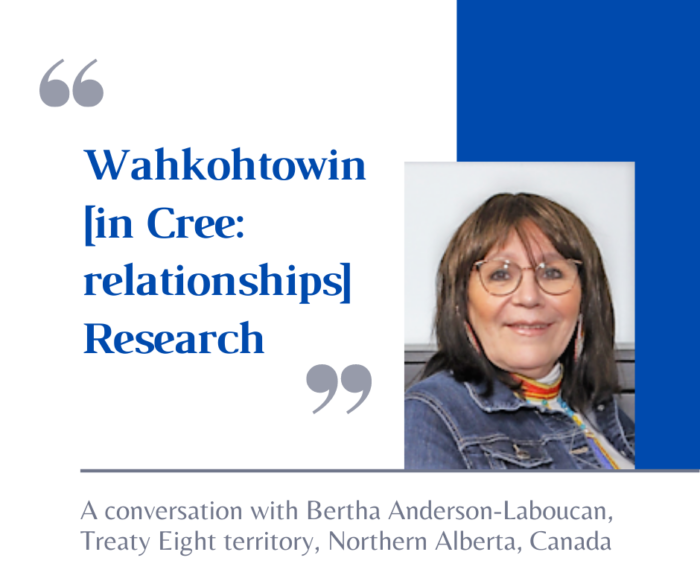Wahkohtowin [in Cree: relationships] Research
This conversation explores the practice of self-location. Indigenous people self-locate every time they introduce themselves by asking each other “Where are you from? Who is your family? And which community are you from?” They live by the concept of “wahkohtowin” (all my relations). Self locating oneself is extremely important in First Nation communities as it immediately provides a deeper understanding of the individual through their linkages. The researcher will therefore want to share about him/herself too. It is critical when trying to establish rapport or in developing a trusting relationship with a participant.
Bertha Anderson-Laboucan
Tanisi (hello) niya (I’m) nisihkason (my name is) Bertha Anderson Laboucan. I am a First Nation, Nehiyaw, Iskwew (Cree Indian woman) from the Treaty Eight territory. My first language is Cree; I speak it fluently. I am a mother, Kookum (grandmother), educator, social worker and activist. My cultural experiences, my family, my community, my upbringing, my traditional teachings, my education, and my work forms my identity. I identify myself through my family, the community I am from, the relationship I have with the land by simply saying “Tansi niya Bertha Anderson-Laboucan”. It is common practice for Indigenous people to ask which family I am from. First Nation people who live on reserves will recognize you by your last name, language and the territory or reserve that you are from; for example, if they know someone from that reserve or if you speak Cree, then it creates space for dialogue to begin at a deeper level. Indigenous people are all about kinship ties, cultural traditions and live by the concept of “Wahkohtowin” (all my relations).
I spent all of my childhood living in a remote community in Northern Alberta, which provided me with the opportunity to be grounded in the knowledge systems, values and experience of my community. I was raised living off the land and continue to practice and respect my community traditions in my everyday life. For example, in case of sickness, my community uses therapeutic roots and herbs that grow in our area. Additionally, elders teach us to heal using our ceremonies, such as smudging and attending a sweat lodge. When I am in nature, I feel a sense of peace and healing. Indigenous ways of knowing and working is how I make sense of the world and decolonize. Kress (2014) stated “Indigenous ‘ways of knowing,’ ‘ways of being’ and ‘ways of doing’ are intuitive and driven from a context of spiritual and cosmic understanding” (p. 11). These personal experiences in life, work and education have helped shape my personal model of social work practice.
Click the image to access the video.
On YouTube, to add subtitles and choose your language: click CC at the bottom of the video to turn subtitles on, then click the Settings icon, go to Subtitles/CC, choose English or Auto-Translate and your desired language.

